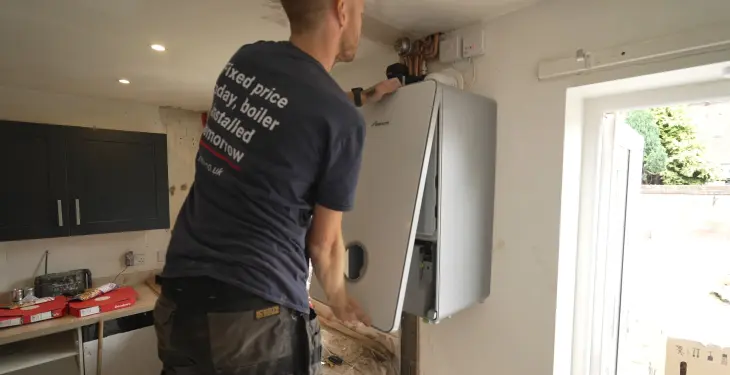

Written by Stephen Day
Gas Safe Engineer
Updated: 30th May, 2025
Boiler error codes are sequences of numbers or letters displayed on the control panel of your boiler. These codes surface when the boiler's internal diagnostics detect irregularities in operation.
Get a new boiler quote, save up to £550 per year (0% APR available).
Experiencing a malfunction with a Worcester boiler can be disconcerting, especially when the display shows an E9 fault code. This particular code is an indication that the boiler's safety mechanisms have been triggered due to an internal issue, causing the boiler to halt operation. The code is typically linked with high temperatures that exceed the system's designed safety parameters.
The E9 fault often points towards problems such as a malfunctioning safety temperature limiter, a blocked or faulty pump, issues with the heat exchanger, or a damaged printed circuit board (PCB). It is important for the safety and functionality of the boiler that this fault is addressed promptly. While some issues may be resolved through straightforward methods such as resetting the system, others may necessitate professional assistance.
Boiler error codes serve as a diagnostic toolbox for homeowners and engineers, revealing issues within the heating system that call for attention.
Boiler error codes are sequences of numbers or letters displayed on the control panel of your boiler. These codes surface when the boiler's internal diagnostics detect irregularities in operation. Fault codes pinpoint specific problems, ranging from minor sensor malfunctions to critical safety issues. The display of these codes typically prompts the user or a professional engineer to investigate and conduct necessary repairs.
Each manufacturer has their unique set of error codes. For instance, a Worcester boiler may flash an E9 code, indicating a precise fault that needs addressing. The presence of these codes simplifies the process of troubleshooting, as it directs the engineer to the potential component or system that may be causing the disruption in service.
Recognising and understanding boiler error codes is imperative for maintaining a safe and functional central heating system. When a boiler displays an error code, it signifies that the system has encountered an issue which could range from low water pressure to a full-scale component failure.
For optimal maintenance, homeowners should refer to the boiler's manual for an explanation of common fault codes. Grasping the significance of these codes, especially cause codes related to specific faults, enables a timely response, potentially preventing further damage to the boiler and avoiding costly repairs. Moreover, comprehending error codes allows the homeowner to articulate the issue accurately when they contact a certified engineer to diagnose and fix the problem systematically.
The E9 fault code on a Worcester Bosch boiler is an indicator of specific issues typically related to overheating and can impact the system's performance significantly.
The E9 fault code specifically points to a problem within the boiler's temperature sensors, heat exchanger, or the high limit thermostat. When this code appears, it is often accompanied by a cause code displayed on the boiler's control panel. These cause codes help identify the exact nature of the problem. The range of cause codes linked to E9 includes 219, 220, 221, and 224, with each pinpointing a different fault such as water damage, limescale buildup, or a flue issue leading to an unsafe operational condition.
Several potential reasons for an E9 fault code are known to affect Worcester boilers, among which a few stand out:
A fault with the safety temperature limiter: The boiler stops functioning when it detects unsafe temperatures.
Overheating issues within the system: This can be due to a build-up of limescale, heating sludge, or rust, which also contributes to wear on the heat exchanger.
Faulty sensors: These sensors, intended to monitor temperature, can become inaccurate due to damage or failure.
A blocked or faulty pump: Obstructed by debris such as grit, a pump that can't circulate water causes heat accumulation.
Damage to the Printed Circuit Board (PCB): Vital for boiler operation, any damage here can lead to incorrect readings and boiler response.
Activating the high limit thermostat or flue: A safety feature that kicks in to prevent damage from excessive temperatures.
Understanding these potential issues is essential for diagnosing and addressing the E9 fault code effectively.
The display of an E9 fault code on a Worcester boiler alerts the user to specific malfunctioning components, such as the pump or sensors, often caused by overheating or limescale build-up.
Pump Issues: A boiler's pump circulates hot water through the system. If the pump is faulty or blocked, the circulation of water is compromised, which can contribute to the E9 fault.
CH Flow Problems: Central Heating (CH) flow difficulties arise when the heat is not being distributed properly, possibly due to a malfunctioning pump or sensor within the system.
Overheating: This is a critical sign where the boiler shuts down to prevent damage. Overheating can result from various issues including, but not limited to, a faulty heat exchanger or a build-up of limescale.
Faulty Sensors: Sensors monitor temperature and pressure. When sensors fail, they can falsely trigger an E9 fault or fail to report an existing issue that leads to the fault.
Heat Exchanger Complications: The heat exchanger is essential for transferring heat to water in the system. If it is faulty, it could cause an imbalance in temperature, triggering the E9 code.
Limescale Build-Up: In areas with hard water, limescale accumulates within the boiler's components over time, potentially leading to malfunctions and inefficiencies, including the E9 fault.
Each symptom noted above directly relates to the E9 error, illustrating the boiler's inability to operate safely and prompting a need for immediate investigation and repair.
When faced with the E9 fault code on a Worcester boiler, homeowners may wonder whether they can resolve the issue without professional assistance. The possibility of DIY fixes depends greatly on the nature of the problem and the individual’s technical competence.
Certain issues causing the E9 error code may fall within the scope of DIY measures, provided one has a basic understanding of boiler operations.
Sensors: Regularly check and clean the boiler’s sensors. Accumulated dirt can sometimes cause sensors to transmit erroneous signals.
Frozen condensate pipe: If the condensate pipe is frozen, applying warm water to thaw it can rectify the issue. However, this should be done cautiously to avoid damages.
Magnetic filter: The magnetic filter should be checked and cleaned periodically to ensure it is free from debris, which can affect the boiler's performance.
While some issues can be addressed with a DIY approach, others require the attention of a trained professional.
Repair: If the problem involves the internal components of the boiler, like the heat exchanger or printed circuit board (PCB), it's advisable to contact a qualified engineer.
Pump: A faulty or blocked boiler pump is a complex component to replace or repair, and therefore, should be handled by professionals.
Whenever undertaking any DIY work on a boiler, individuals must ensure they are not breaching any safety regulations or warranty terms. If in doubt, it is always safer and more reliable to call a certified technician.
When an E9 fault occurs on your Worcester boiler, understanding when professional help is required is key. Safety and regulations stipulate the necessity for certified intervention in certain instances.
An E9 error code signifies that the boiler's safety temperature limiter in the central heating flow has activated. This usually happens when water temperature exceeds a safe limit, potentially indicating a more serious malfunction.
Situations necessitating a Gas Safe engineer's assistance include:
Persistent error display: If the E9 code doesn't clear after a reset.
Boiler performance issues: Such as unusual noises or leaking.
Lack of heating or hot water: Suggesting the boiler isn't operating effectively.
Responding promptly to these signs is crucial, as they can escalate into more complex and costly repairs.
A Gas Safe registered engineer is qualified to work safely and legally on gas appliances. They possess the necessary skills and tools to diagnose and repair intricate boiler issues, adhering to strict safety standards. Employing a Gas Safe engineer ensures:
Compliance with legal requirements: It's unlawful for unregistered individuals to work on gas appliances.
Expert fault diagnosis: Their specialised training enables them to accurately identify and resolve faults.
Warranty preservation: Unauthorised repairs might void your boiler warranty.
It's essential to verify an engineer's Gas Safe registration before commissioning them for boiler service or repair tasks to guarantee your appliance is in competent hands.
Repair costs for the E9 fault in Worcester boilers can vary, but understanding the general expenditure, influencing factors, and new boiler prices provides clarity for consumers facing this issue.
The repair cost for an E9 fault code on a Worcester boiler typically ranges between £180 and £300. This estimate includes both labour and parts. While a damaged printed circuit board (PCB) can be on the higher end, simpler fixes may fall toward the lower end of the spectrum.
Type of fault: The nature of the issue, such as a faulty safety temperature limiter or a blocked pump, can influence the overall cost.
Engineer's fees: The hourly or fixed rate of a certified engineer significantly impacts the repair bill.
Part replacements: High-quality replacement parts for a Worcester boiler may cost more, particularly if a major component like a PCB requires replacement.
Boiler's age and warranty status: An out-of-warranty boiler may incur higher repair costs, while boilers still under warranty might benefit from reduced rates or covered parts.
Boilers can be a daunting purchase for many people as they’re an appliance with a lot of responsibility, providing heat for you and your family is something you want to get right. Boilers aren’t exactly a quickly disposable item either, potentially lasting you a decade.
Effectively, new boiler cost can be split into two segments: the first is the actual boiler itself (unit price), and the second is the cost of the boiler being installed (set up) in your property by an expert engineer.
Here at iHeat, we want to remove all of this undue stress and make the decision making process of upgrading to a new central heating system, as easy as possible.
Boiler costs can vary depending on a number of factors including their brand, model, fuel, output, warranty, labour and installation type. Typically a new boiler will cost between £1,845 and £3,500, below is a list of average boiler installations offered by iHeat (guide only).
Installation Type | Price (inc VAT) | |
Combi to combi swap | £1,845 | |
System to combi conversion | £2,499 | |
New boiler install | £2,899 | |
Back boiler to a combi | £3,299 | |
System to system | £1,945 |
When faced with a Worcester Bosch boiler displaying an E9 fault, homeowners must weigh the pros and cons of repairing against purchasing a new unit.
It's imperative to assess several aspects:
Age: A boiler over 10 years may demand more frequent repairs, and efficiency could have significantly declined.
Cost: If the cost for repair is substantial, one must ponder if that money is better invested in a new boiler.
Frequency of Breakdowns: Recurrent faults imply the boiler's reliability is compromised.
Parts Availability: Older boilers may have parts that are challenging or costly to source.
Energy Efficiency: A new, efficient boiler could reduce the running costs and benefit the environment.
Boilers have an average lifespan of between 10 to 15 years, however, this can vary widely based on the make and model, usage patterns, and whether it has been regularly serviced.
Lifecycle: A Worcester Bosch boiler typically exhibits a robust lifecycle, yet is not immune to wear and tear experienced over a decade or more.
Heat Exchanger: This critical component can corrode or suffer from limescale buildup. If compromised, it can be a costly replacement.
Central Heating System: Upgrading your boiler can lead to a more efficient central heating system, saving money and energy in the long run.
It's prudent to consult with a certified HVAC professional who can advise on the condition of your existing boiler and the benefits of the latest models.
In addressing the E9 fault code on Worcester boilers, it is evident that the code signals an overheat error typically originating from a few possible sources. These include a safety temperature limiter engagement, a malfunction in the heat exchanger, issues with the boiler pump, or a damaged printed circuit board (PCB).
For a definitive resolution, professional assessment is recommended. One's safety should be the priority; hence, DIY should be approached with caution, particularly if one lacks specific expertise in boiler systems. It is prudent to consult with a Gas Safe registered engineer, who can diagnose the fault accurately and provide a safe, efficient fix.
In the interim, it is sensible to refrain from using the boiler to avoid potential complications. Regular maintenance can preempt such faults, emphasising the magnified importance of periodic checks. Should you encounter an E9 error, it is advisable to action promptly, securing the longevity and reliability of your heating system.
Ultimately, the E9 fault code is an indicator that should not be overlooked. It serves as a critical alert to prevent further damage to the boiler and maintain the safety of the household. Through expert intervention, one can ensure that their heating system remains operational and efficient for years to come.
Last updated: 30th May, 2025

Written by Stephen Day
Gas Safe Engineer at iHeat
Stephen Day is a Gas Safe registered and FGAS certified engineer with over 20 years of hands-on experience in the heating, cooling, and renewable energy industry, specialising in boiler installations, air conditioning, and heat pump systems.
LinkedInArticles by Stephen Day are reviewed by iHeat’s technical team to ensure accuracy and reliability.

22nd December, 2025
Based on data from over 7000 boiler installations completed by iHeat in the past 12 months...
 Read Article
Read Article

22nd December, 2025
Here’s a quick roundup of the best combi boilers for 2026.
 Read Article
Read Article

22nd December, 2025
When your old boiler breaks down and it comes time to replace it with a new one, it might...
 Read Article
Read Article
No obligation. Takes less than 60 seconds.